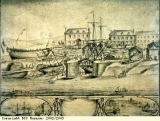The slave economy in Bristol
Bristol was already a thriving port before the local merchants became involved in the slave trade. The docks were full of ships, as shown on this map of 1670. Trade with western and northern Europe had, from the medieval period (c. 1200-1485), made Bristol the second richest city of the kingdom after London. Woollen cloth from Somerset and Gloucestershire was the main export from the port. Imports included olive oil and wine from the Mediterranean countries (such as Spain and Italy), and timber from northern Europe.
The slave trade opened up new prospects for the city. Local manufacturing industry could supply some of the trade goods needed to exchange for slaves in Africa. The developing colonies owned by the Europeans in North America and the Caribbean islands needed supplies from Europe. The slave-produced goods such as sugar and tobacco, grown on the European-owned plantations, were shipped to Bristol and provided new industries and markets for the city. The only problem was that trade with Africa was in the hands of the Royal African Company. This was a company of London-based merchants (including the Bristol-born Edward Colston) who had a monopoly on the African trade. The merchants of Bristol, organised into the Society of Merchant Venturers, campaigned to have this monopoly control lifted so that they could join the trade. In 1698, the Royal African Company lost its monopoly position, and Bristol’s merchants were free to join the trade in enslaved Africans.



